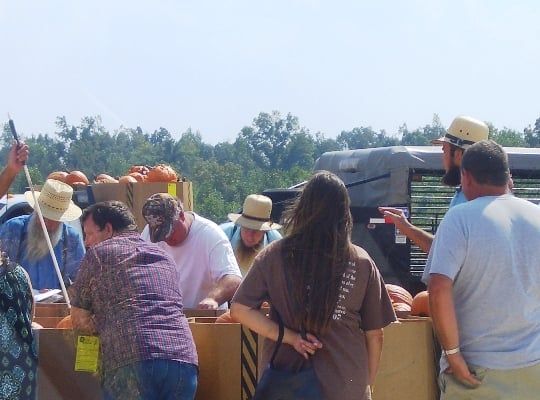A New Map Highlights 17 Businesses in Kentucky’s Largest Amish Community
I like drawing attention to these Amish business maps, and it seems more and more communities are creating them. Other recent examples we’ve seen include maps for communities in Buchanan County, Iowa, Livingston County, New York, and Crittenden County, Kentucky. It makes sense as a good way to attract visitors and of course supports the local Amish community.
The map we look at today features 17 Amish businesses in Kentucky’s largest community, in Hart County (aka the Munfordville/Horse Cave settlement). You can view it here below, or at the Hart County Tourism Facebook page.

I found this via a story at wbko.com on the Dutch Country Safari Park, one of the Amish-owned businesses listed on the map. There is something like this in the Holmes County settlement (The Farm at Walnut Creek). You drive through to experience the safari part, and there is also a petting zoo.
The country tourism director in the WBKO video says that there are over 100 Amish businesses in this settlement, and that they selected the ones they felt were potentially most appealing to visitors. She adds that they were getting “overwhelming requests for information about our Amish businesses” thus the idea for the map.
Tourism in general benefits Amish. Overall I would call it a net-positive. Now the hyper-visited places like Intercourse, PA are of course examples were tourist traffic brings some negatives as well. But in the less-frequently visited places in particular, the negatives are minimal if they exist at all.

Other businesses on the map include bakeries, greenhouses, a country store, fabrics shop, and a variety store. I visited this community over 10 years ago and it’s certainly grown a good bit since then. I stopped in at at least one of these Amish places (Detweiler Country Store). Two others I visited, which are not on this list, are Clothes and Crafts Cottage, and Anna’s Kitchen, which sells/sold jams and jellies. I don’t know if those two are not in business any longer, or simply didn’t make the cut to get on the map.
As for the community, here’s a sample of what I wrote about the settlement at the time:
In some respects the area resembles the Holmes County, Ohio Amish settlement, due to the many hills, winding roads, and “hollers” you come across as you drive through the community. It’s easy to get lost as you drive about. On one occasion I followed a road that trailed off into a field. Others cut through back woods, with few inhabitants to be found.
As in Holmes County, the very hilly terrain can cause dangers for horse-and-buggy travelers. In addition to standard buggy warning signs, on some of the steeper and more dangerous hills and curves you find gravel pull-offs, where carriages can pull over out of traffic.
The Green River bisects the settlement, winding between the two towns. Apparently bridges are few and far between; an Amish woman explained to me that at one location you had to travel 13 miles around to get to the other side, though locals take boats across as well.
You can read the rest of that post here. Hart County has 19 Amish church districts and well over 2,000 Amish residents. This Amish community is one of the largest in the South. I expect it will continue to grow as an attractive tourist destination, especially as word gets out about this anchor showcase safari park business.








Thanks for this interesting post about the Munfordville, Ky. settlement.
I’ve visited 42 settlements in 11 states, and the Munfordville settlement continues to be one of my favorites for two reasons: 1) some unique Amish stores, and 2) the beauty of the area.
I hadn’t seen the “Amish-Owned Businesses” brochure for the area before today’s post, but in reviewing it now, I think it lists the businesses I would suggest a visitor new to the area visit. I have visited thirteen of the businesses at one time or another, but three that I always visit are
R & S Grocery & Bakery, Detweiler’s Country Store and Abe’s Place. I always call Detweiler’s an “Amish strip mall” because there are several buildings with merchandise on the same small homestead, including the Crazy Bear Trading Post. When I visited this spring they also had a greenhouse selling plants. Abe’s Place is a unique Amish consignment shop with a good number of stands inside the building. Also, I’m wondering if the “Backroad Artist”, Amishman D. L Yoder is still selling his artwork anywhere in the area. He has beautiful paintings on turkey feathers, as well as prints. I would suggest new visitors ask around at Detweiler’s or Abe’s Place to see if the artwork is still available. The Hart County Produce Auction is also very enjoyable to attend during produce season.
Hart County is a beautiful area, especially in the springtime and autumn. I would suggest to a new visitor to especially take time to enjoy the beauty of the area around Cub Run Hwy. 88 between Munfordville and Cub Run. There are lots of hilly side roads branching off of the Highway.
I haven’t found any restaurant that features “Amish-style” food in the area, so I usually get a good sandwich either at Detweiler’s or the deli in R & S Grocery. They both also sell very good baked goods. I’ve also had some very good food at the annual Spring Consignment Sale.
I do wonder a little about the statistics that are listed in the Amish Businesses brochure when it says that “Approximately 200 families now live throughout the county…” In the Jan. 21, 2015 issue of The Budget newspaper, an Amish news reporter from the settlement reported at that time there were 358 families in 14 church districts. The most current statistics from the Young Center reports that there are now 19 districts. I hope to visit the settlement in Oct. and I’m going to ask at Abe’s Place or Detweilers what they think the present number of Amish families is in Hart County.